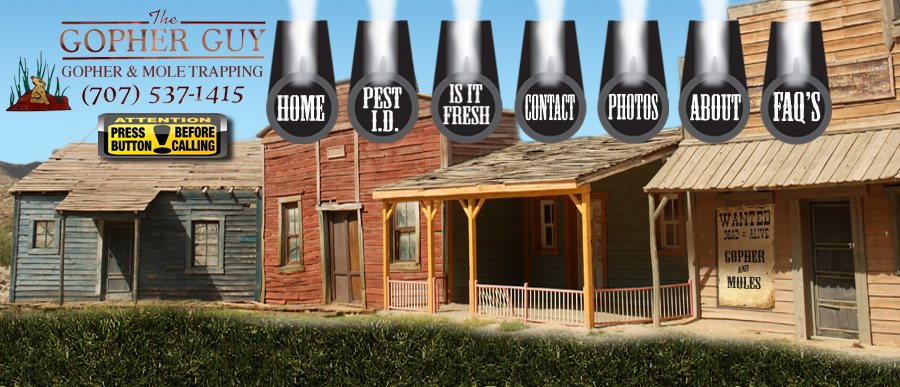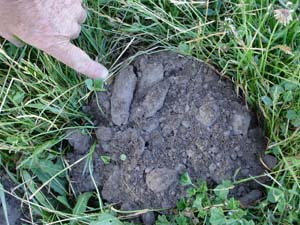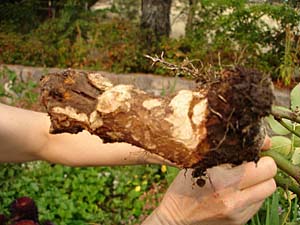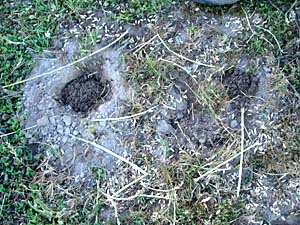
IMPORTANT PEST IDENTIFICATION:
Please Read This Before Calling Us Out!
IS IT A GOPHER OR A MOLE?
Pocket GOPHERS are easily confused with several mammals such as MOLES, VOLES, ground squirrels,
chipmunks, rats, and more. It is absolutely necessary to correctly identify your pest. If you are not sure,
please spend a few minutes reading and looking at the photos. Compare your situation and identify your pest.
Trap size and methods are specific for MOLES and different for GOPHERS. We do NOT recommend using our service
if you cannot identify your pest.
- Mole Identification
- Moles, what to look for
- Gopher Identification
- Vole Identification
- Go to page top
- HOME
MOLE IDENTIFICATION
Part of the frustration in dealing with these pests, especially moles, is that we never actually see them;
we only see the damage that has been done by them and the truth is, we may never see them.
Moles are not a rodent, they are an insectivore related to the bat and shrew family, feeding mainly
on earthworms, but they also feed on snails, slugs, millipedes, centipedes, but rarely vegetation. Moles
eat live prey and cause little or no damage to perennial landscape plants. They prefer to live in moist
shady areas and most often invade from woodlands. They may damage delicate annuals by creating air pockets
around roots, and cause extensive cosmetic damage to lawns and other garden areas, but moles are not after plants.

This photo was taken after the mole was removed from the trap.
Rarely, will you see a mole above ground.
MOLES? WHAT TO LOOK FOR
Mole signs may include mounds, raised ridges, or both, depending upon soil conditions. Moles prefer moist areas
where the grubs and worms are plentiful. These shallow surface tunnels often follow along a house foundation,
driveway, lawn border or other solid object.

The photo above is a raised ridge or shallow mole run in moist soil along a walkway.

The photo above is also a raised foraging tunnel with mole mounds in the background.
These raised mole runs will often make lawn or flower beds feel "squishy" when you walk on it.
When moles arent foraging for food under the surface, they are excavating. They push dirt straight up resulting
in regular conical or volcano shaped mounds that are fairly uniform in shape, though may vary in size.

The photo above shows a typical symmetrical conical shaped mole mound.
Note the soil is made of sand.

Another typical conical shaped mound characteristic of a mole.
Note the dirt clods that are also characteristic of a mole. Gophers will not make these kinds of
mounds or dirt clods.
A burrow system is a vast network of interconnecting tunnels and passages.
Tunnels vary in depth from 3 to 30 inches. Moles are active year round and
make regular use of their tunnels. If the food source becomes scarce in the
upper soil levels, moles will move into deeper tunnels, or extend the tunnel
system 50-60 yards in one night in search of food. Moles will even use dirt
from new excavations to plug up old tunnels, fooling you into thinking he
has left only to emerge in a month with several mounds. The number of
mounds or ridges in any given area does not indicate the number of moles
present. A single mole might construct from 50 to 100 mounds in a month.
Moles average only about two (2) per acre.

This series of mounds are characteristic of a mole system as seen from above ground.
Return to Index at top page
GOPHER IDENTIFICATION
Gophers are often mistaken for moles. Gophers do not have the huge spade-like feet like moles do, but they
can certainly do as much, if not more damage.

Gopher eyes and ears are barely visible, but the sensitive whiskers and tail make up for the
weakness in their hearing and sight.
The Pocket Gopher is named for its external fur-lined cheek pouches that he uses to carry roots, tubers and
other vegetative matter.

Look what plants Ive been eating!
A gopher is strictly an herbivore. Gophers cut roots of trees and vines and gnaw the bark of trees, at times
completely encircling them so they die. The gopher cuts the roots of plants beneath the surface, then pulls
the rest of the plant into the burrow. They can consume and destroy large amounts of vegetation.

Here is evidence of gopher damage. A Hydrangea root ball eaten away by one gopher.

Here is more evidence of gopher damage.
This gopher is eating away at the roots of this ornamental tree.
As a gopher digs tunnels and pushes dirt to the surface, he comes to the surface at an angle, resulting in
crescent or irregular shaped mounds, and the plugs are visible. These crescent shaped mounds with a plug at the
top are produced while tunneling for succulent portions of plant.

Notice the crescent shape with the plug, unlike a mole mound that is conical shaped and never has a plug.

Two gopher mounds, but still the crescent with the plug.
In addition to creating mounds and eating roots from underground, gophers
will dig open holes to the surface to feed on surface vegetation. Some
feed holes are only the size of a silver dollar, other feed holes are
2 to 3-inches across. You must really be observant to spot the small ones.
The size of the feed hole is determined by the size of the gopher. The same
rule applies for the diameter of the tunnel. The bigger the tunnel the bigger
the gopher. However, it really gets confusing when a small gopher moves into
an abandoned tunnel where a large adult gopher once lived. That is where
years of experience helps.

Gophers will plug their hole after it is done feeding.

More Feed Holes.
Notice how the vegetation has been eaten away around the opening of the hole.
These holes will be plugged with soil after the gopher is done feeding at a
location. Look for fresh, plugged "feeder holes" with grass or other plants
chewed or eaten around perimeter of hole. We will discuss how to identify
freshly dug mounds and plugged feed holes on "is it fresh" page.

A flag is placed at each mound showing the tunneling system of ONE gopher!
Tunnels vary from 2 to 3 inches in diameter. These tunnels are most often parallel to
the surface, usually at depths from 6 to 12 inches, with secondary
tunnels down 24 to 36 inches. A gopher is capable of hiding his activity by
back filling tunnels that are no longer needed with dirt from new excavation.
Gophers can live in moist to dry soil but avoid saturated areas, and most
often invade from sunny wild lands or turf areas such as parks.

Gophers are active year round, solitary and territorial. An adult male gopher
can control territory up to 2000 square feet. A gopher will dig up to 7 or 8
tunnels which may extend as much 800 feet each.
Return to Index at top page
VOLE IDENTIFICATION
Voles, also known as field mice, are common pests in lawns and gardens.
VOLES are often confused with a GOPHER. A full grown VOLE will be about the size of a young GOPHER.
The fur can be dark brown like a mature GOPHER, but unlike GOPHERS, VOLES have mouse-like ears.
VOLES can create damage to trees, shrubs, bulbs, and perennials like a GOPHER, but the open tunnel
is characteristic of VOLES. While A GOPHER plugs the tunnel, VOLES leave very clean, very round,
polished, open holes and beaten down pathways through the grass. Nature has not equipment VOLES
to be diggers, so generally, VOLES take over abandoned MOLE and GOPHER tunnels. Unlike GOPHERS
who are strictly herbivores, on occasion, VOLES are cannibalistic. I have pulled MOLES and GOPHERS
from my traps and found the carcass eaten from the tail forward by a group of VOLES. The photo is
an example of an abandoned GOPHER system that VOLES have taken over. Our traps work only on MOLES
and GOPHERS, so it is important to identify the pest creating damage to your property before requesting
our service.

Voles invade abandoned tunnels made by moles and gophers rather than dig their own.
ATTENTION
We are now licensed to trap; skunks, possums, raccoons, squirrels, gophers, moles, and voles
Return to Index at top page
Home
© Copyright 2012 The Gopher Guy. All Rights Reserved.